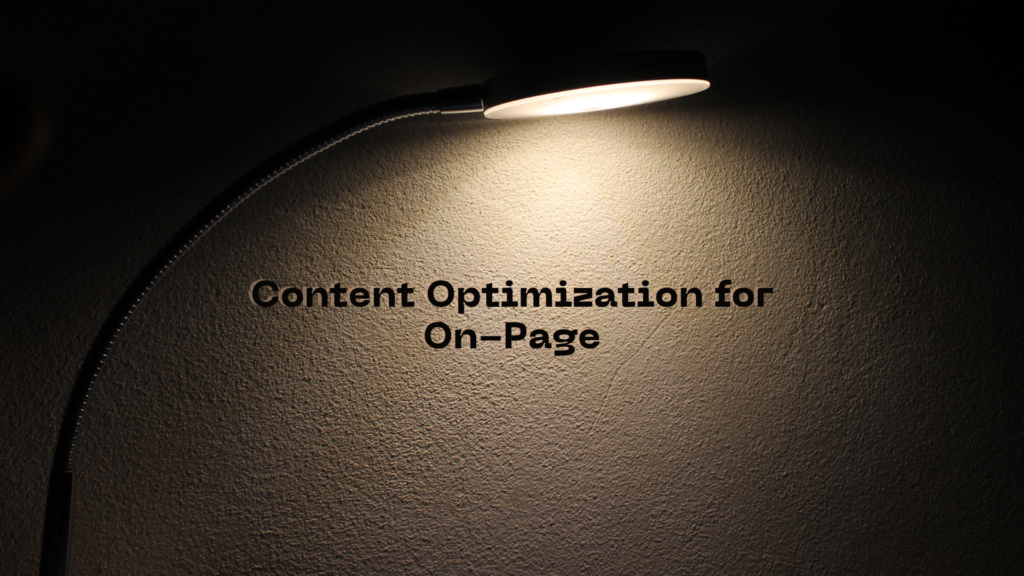In the ever-evolving landscape of digital marketing, one term that has remained constant is “SEO” or Search Engine Optimization. Whether you’re a seasoned marketer or just dipping your toes into the world of online content, understanding the fundamentals of SEO is crucial for success. This guide will take you through the basics of content optimization for on-page dominance, helping you improve your website’s visibility, and ultimately, driving more organic traffic.
i)Understanding SEO: The Foundation of Online Success
Before diving into content optimization, let’s establish what SEO is and why it’s essential. SEO is a set of strategies and practices aimed at enhancing a website’s visibility in search engine results pages (SERPs). It’s the art of making your content discoverable to users searching for relevant information
ii)Keyword Research: The Backbone of Content Optimization
Keyword research is the starting point of any successful SEO strategy. It involves identifying the words and phrases your target audience is likely to use when searching for information related to your industry or niche. There are various tools available, like Google Keyword Planner and SEMrush, that can assist you in finding the right keywords for your content.
iii)Quality Content: The Heart of On-Page SEO
Once you’ve identified your target keywords, it’s time to create high-quality content around them. Content that’s engaging, informative, and valuable to your audience not only helps with SEO but also keeps your visitors on your site longer. Here are some key aspects to consider:
- Originality: Ensure your content is unique and not copied from other sources. Plagiarism can harm your website’s rankings.
- Relevance: Keep your content relevant to the chosen keywords. Don’t veer off-topic.
- Length: While there’s no one-size-fits-all rule, longer, comprehensive content tends to perform better in search results.
- Readability: Use clear, concise language and break up your content with headings, bullet points, and images to make it more reader-friendly.
- Multimedia: Incorporate images, videos, infographics, and other multimedia elements to enhance the user experience
iv)On-Page Optimization: The Technical Side
Beyond content quality, there are technical aspects to consider for on-page optimization:
- Title Tags: Craft compelling title tags for your pages, including the target keyword.
- Meta Descriptions: Write concise and enticing meta descriptions that encourage clicks.
- Headers: Use H1, H2, and H3 headers to structure your content and make it easier to read.
- URL Structure: Create clean and descriptive URLs for your pages.
- Image Alt Text: Add descriptive alt text to images for accessibility and SEO benefits.
- Internal Linking: Link to other relevant pages within your website to improve navigation and SEO.
v)Mobile Optimization: A Must
With the majority of internet traffic coming from mobile devices, it’s essential to have a mobile-friendly website. Google even uses mobile-friendliness as a ranking factor. Ensure your site’s design is responsive and offers an optimal user experience on all devices.
vi)Page Loading Speed: Patience is Thin Online
Page loading speed plays a significant role in both user experience and SEO. Slow-loading pages can deter visitors and negatively impact your search rankings. Use tools like Google PageSpeed Insights to identify and address speed issues.
vii)Regular Content Updates: Stay Relevant
Search engines favor websites that regularly update their content. Fresh content not only attracts search engine bots but also keeps your audience engaged. Consider publishing blog posts, news articles, or other updates to maintain a dynamic web presence.
viii)User Engagement and Social Signals: Quality Over Quantity
Engagement metrics, such as bounce rate, time on page, and social media shares, can indirectly influence your SEO. Quality content that resonates with your audience tends to have better engagement metrics, so focus on delivering value rather than obsessing over metrics.
ix)Monitor and Adapt: SEO is a Continuous Journey
SEO is not a one-and-done task. It requires continuous monitoring and adaptation. Tools like Google Analytics and Google Search Console can help you track your website’s performance and identify areas for improvement.
x)Seek Professional Guidance When Needed
If you find SEO overwhelming or lack the time to handle it yourself, consider consulting with a professional or hiring an SEO agency. They can provide expert guidance and ensure your website’s on-page optimization is on point.
Conclusion
Content optimization for on-page dominance is an essential aspect of modern digital marketing. By understanding the basics of SEO, conducting thorough keyword research, creating high-quality content, and optimizing your website technically, you can improve your online visibility and attract a larger, more engaged audience. Remember that SEO is an ongoing process, so stay committed to continuous improvement and adaptation to stay ahead in the digital race.


Pingback: Boost Your SEO Ranking: The Impact of Page Loading Speed and Mobile Friendliness -
Pingback: What is On-Page SEO?